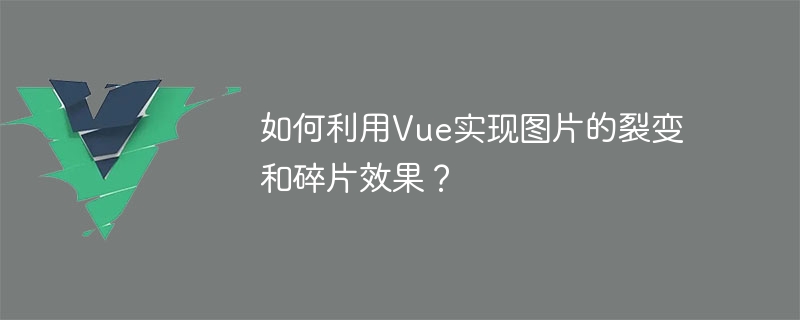

Vue を使用して画像の分裂と断片化の効果を実現するにはどうすればよいですか?
フロントエンド開発では、ユーザー エクスペリエンスを向上させるために、Web ページに特殊効果を追加することが必要になることがよくあります。その中でも、写真の分裂効果や断片化効果は、より一般的な特殊効果の 1 つです。この記事では、Vue フレームワークを使用して画像の分裂と断片化の効果を実現する方法を紹介し、関連するコード例を添付します。
assets フォルダーに保存し、コンポーネント内で参照できます。 template では、<img src="/static/imghw/default1.png" data-src="imageUrl" class="lazy" alt="Vue を使用して画像の分裂と断片化の効果を実現するにはどうすればよいですか?" > タグを使用して画像を表示できます。同時に、核分裂と断片化の効果を実現するには、data でいくつかのステータス値を定義し、アニメーション効果の表示を制御する必要があります。 <template>
<div>
<img src="/static/imghw/default1.png" data-src="imageUrl" class="lazy" : : style="max-width:90%" alt="" />
<div class="particles" :style="particleStyle" v-if="showParticles"></div>
</div>
</template>
<script>
export default {
data() {
return {
imageUrl: require('@/assets/image.jpg'), // 替换成你的图片地址
imageStyle: {
width: '500px', // 根据图片大小设置宽度
height: 'auto', // 根据图片宽高比计算高度
position: 'relative',
},
particleStyle: {
position: 'absolute',
width: '10px',
height: '10px',
background: 'red', // 碎片的颜色
},
showParticles: false, // 是否展示碎片
}
},
mounted() {
// 设置一个定时器,在3秒后展示碎片效果
setTimeout(() => {
this.showParticles = true;
}, 3000);
},
}
</script>
<style scoped>
.particles {
width: 100%;
height: 100%;
overflow: hidden;
}
</style>mounted フックで canvas を使用して、画像を加工します。具体的な手順は次のとおりです。 canvas 要素を作成し、画像と同じ幅と高さを設定します。 canvas のコンテキストを取得し、drawImage メソッドを使用して画像を canvas に描画します。 getImageData メソッドを使用して画像のピクセル データを取得し、各ピクセルを処理します。 fillRect メソッドを使用して canvas 上に小さな四角形を描画し、核分裂効果を形成します。 以下は、核分裂効果のコード例です:
<template>
<div>
<canvas ref="canvas" :width="canvasWidth" :height="canvasHeight" />
<div class="particles" :style="particleStyle" v-if="showParticles"></div>
</div>
</template>
<script>
export default {
data() {
return {
imageUrl: require('@/assets/image.jpg'), // 替换成你的图片地址
imageStyle: {
width: '500px', // 根据图片大小设置宽度
height: 'auto', // 根据图片宽高比计算高度
position: 'relative',
},
particleStyle: {
position: 'absolute',
width: '10px',
height: '10px',
background: 'red', // 碎片的颜色
},
canvasWidth: 500,
canvasHeight: 0,
showParticles: false, // 是否展示碎片
}
},
mounted() {
const canvas = this.$refs.canvas;
const ctx = canvas.getContext('2d');
const img = new Image();
img.src = this.imageUrl;
img.onload = () => {
this.canvasHeight = (img.height * this.canvasWidth) / img.width;
canvas.width = this.canvasWidth;
canvas.height = this.canvasHeight;
ctx.drawImage(img, 0, 0, this.canvasWidth, this.canvasHeight);
const imageData = ctx.getImageData(0, 0, this.canvasWidth, this.canvasHeight);
const pixels = imageData.data;
// 对每个像素进行处理
for (let i = 0; i < pixels.length; i += 4) {
const r = pixels[i];
const g = pixels[i + 1];
const b = pixels[i + 2];
const a = pixels[i + 3];
const x = (i / 4) % this.canvasWidth;
const y = Math.floor(i / 4 / this.canvasWidth);
if (Math.random() < 0.5) {
ctx.fillStyle = `rgba(${r},${g},${b},${a / 255})`;
ctx.fillRect(x, y, 1, 1);
}
}
// 定时器,在3秒后展示碎片效果
setTimeout(() => {
this.showParticles = true;
}, 3000);
};
},
}
</script>data フラグメントの数と位置を制御する変数をいくつか定義します。次に、mounted フックの v-for ループを使用してフラグメントを生成し、その位置とアニメーションを設定します。 以下は断片化効果のコード例です:
<template>
<div>
<canvas ref="canvas" :width="canvasWidth" :height="canvasHeight" />
<div class="particles" v-if="showParticles">
<div
class="particle"
:class="'particle-' + index"
v-for="(particle, index) in particles"
:key="index"
:style="{ left: particle.x + 'px', top: particle.y + 'px', animationDelay: particle.delay + 'ms' }"
></div>
</div>
</div>
</template>
<script>
export default {
data() {
return {
imageUrl: require('@/assets/image.jpg'), // 替换成你的图片地址
imageStyle: {
width: '500px', // 根据图片大小设置宽度
height: 'auto', // 根据图片宽高比计算高度
position: 'relative',
},
particleStyle: {
position: 'absolute',
width: '10px',
height: '10px',
background: 'red', // 碎片的颜色
},
canvasWidth: 500,
canvasHeight: 0,
showParticles: false, // 是否展示碎片
particles: [], // 碎片数组
}
},
mounted() {
const canvas = this.$refs.canvas;
const ctx = canvas.getContext('2d');
const img = new Image();
img.src = this.imageUrl;
img.onload = () => {
this.canvasHeight = (img.height * this.canvasWidth) / img.width;
canvas.width = this.canvasWidth;
canvas.height = this.canvasHeight;
ctx.drawImage(img, 0, 0, this.canvasWidth, this.canvasHeight);
const imageData = ctx.getImageData(0, 0, this.canvasWidth, this.canvasHeight);
const pixels = imageData.data;
// 对每个像素进行处理
for (let i = 0; i < pixels.length; i += 4) {
const r = pixels[i];
const g = pixels[i + 1];
const b = pixels[i + 2];
const a = pixels[i + 3];
const x = (i / 4) % this.canvasWidth;
const y = Math.floor(i / 4 / this.canvasWidth);
if (Math.random() < 0.5) {
ctx.fillStyle = `rgba(${r},${g},${b},${a / 255})`;
ctx.fillRect(x, y, 1, 1);
}
}
// 初始化碎片数组
for (let i = 0; i < 1000; i++) {
const x = Math.random() * this.canvasWidth;
const y = Math.random() * this.canvasHeight;
const delay = Math.random() * 2000;
this.particles.push({
x,
y,
delay,
});
}
// 定时器,在3秒后展示碎片效果
setTimeout(() => {
this.showParticles = true;
}, 3000);
};
},
}
</script>
<style scoped>
.particles {
width: 100%;
height: 100%;
overflow: hidden;
}
.particle {
position: absolute;
width: 10px;
height: 10px;
background: red; // 碎片的颜色
animation: particle-fade 2s ease-in-out infinite;
}
@keyframes particle-fade {
0% {
opacity: 1;
transform: translateY(0);
}
50% {
opacity: 0;
transform: translateY(20px);
}
100% {
opacity: 1;
transform: translateY(0);
}
}
.particle-0 {
animation-delay: 50ms;
}
.particle-1 {
animation-delay: 100ms;
}
.particle-2 {
animation-delay: 150ms;
}
/* ... */
</style>上記のコード例を通じて、Vue で画像の分裂効果と断片化効果を簡単に実現できます。ページが読み込まれると、画像は最初に断片に分割され、一定のアニメーションの後、最終的に完全な画像が表示されます。実際のニーズに応じてコード内のパラメータを調整して、必要な効果を実現できます。
この記事が、Vue での画像分裂と断片化効果の実装を理解するのに役立つことを願っています。
以上がVue を使用して画像の分裂と断片化の効果を実現するにはどうすればよいですか?の詳細内容です。詳細については、PHP 中国語 Web サイトの他の関連記事を参照してください。